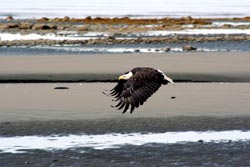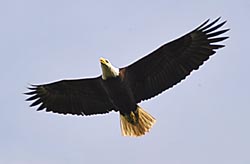Bald
Eagle Facts
The Bald
Eagle (Haliaeetus leucocephalus),
national bird of the
United States (US), is
a large raptor or bird
of prey. The Bald Eagle's
scientific name signifies
a sea (halo) eagle (aeetos)
with a white (leukos)
head (cephalo). At one
time, the word "bald"
meant "white", not
hairless. Adults have
a brown body with a white
head and tail. Immature
Bald Eagles have a dark
head and tail until around
five years of age when
they acquire their white
feathers. Bald Eagles
grow to 28-38 inches,
have a wingspan of 80
inches (nearly seven
feet), weigh between
10-14 pounds and live
to an average of 15-20
years.
| Bald
Eagles are the only
eagle unique to North
America found from
Alaska and Canada to
northern Mexico. About
half the world's 70,000
bald eagles live in
Alaska. Combined with
British Columbia's
population of about
20,000, the northwest
coast of North America
is by far the greatest
stronghold for Bald
Eagles. They flourish
here in part because
of the salmon; an important
food source for all
Bald Eagles. |
 A
Bald Eagle flies
along the coastline
of Homer, Alaska.
A
Bald Eagle flies
along the coastline
of Homer, Alaska.
(Image
by: Nick Hutton) |
Bald Eagles have been making
a comback after many years
of decline, partly due
to the ban of Dichloro-Diphenyl-Trichloroethane
(DDT) and other agricultural
pesticides in the US in
1972 and the protection
offered to the birds by
the Endangered Species
Act of 1973. Until 1995,
the Bald Eagle had been
listed as "endangered"
under the Endangered Species
Act in 43 of the 48 lower
states and listed as "threatened"
in Wisconsin, Minnesota,
Michigan, Washington and
Oregon. In July 1995, the
US Fish and Wildlife Service
upgraded the status of
Bald Eagles in the lower
48 states to threatened.
On June 28, 2007 the US Department
of Interior took the American
Bald Eagle off the Endangered
Species List. It is still
protected by the Migratory
Bird Treaty Act, the Bald
and Golden Eagle Protection
Act and the Bald Eagle
Protection Act.
In New Jersey, only a single
pair of nesting Bald Eagles
was recorded in 1985. In
2008, there were 69 pairs
with 50 nests that produced
85 young. Bald Eagles mate
for life, but when one
dies, the survivor will
not hesitate to accept
a new mate.
Eagles lay from one to three
eggs that are off-white
or buff color and speckled,
about the size of a goose
egg. The eggs are incubated
for 35 days. Although the
female spends most of the
time on the nest both to
keep the eggs warm and
protect them from potential
predators, incubation is
shared by both parents.
When the eaglets are ready to
hatch, they break through
the shell using their egg
tooth, a pointed bump on
the top of their beak.
This can take from 12-48
hours after the first break in
the shell. Newly hatched eaglets
are covered in a grayish-white
down and their eyes are partially
closed.
Eaglets grow quickly, adding
a full pound of body weight
every four or five days.
At three weeks, the eaglet
is about 12 inches tall
with a beak and feet that
are almost the size of
an adult. By six weeks,
the eaglet is nearly the
size of its parents.
At
about 11 or 12 weeks,
the eaglets are ready
to leave the nest
but stay close by
for another six to
nine weeks to practice
their ability to
fly and hunt.
From the time the
parents build the nest
until the time their
offspring are on their
own takes about 20
weeks. During the nesting
cycle, the parents
remain within one to
two miles of the nest. |
 One
of the
Bald Eagles
One
of the
Bald Eagles
soars
above the nest.
(Image by: Kathy Clark, New Jersey Department
of Environmental Protection) |
|

